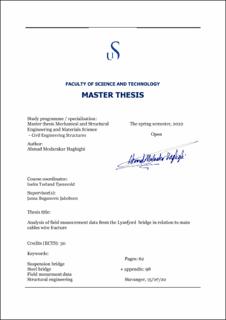| dc.description.abstract | A 637-meter suspension bridge located in Rogaland county, Norway, which connects the two municipalities of Strand and Sandnes, is known as the Lysefjord Bridge. The bridge is located in Rogaland county, and the bridge stretches for 637 meters. With two lanes for vehicles, one lane for pedestrians, and a clearance of 50 meters for ships sailing , the main span is 446 meters long, with side spans of 34.5 meters and 156.5 meters. As a part of the construction, concrete towers and closed steel bridge girders have been used to construct the bridge. As part of the main cable, there is one layer of six locked coil cables that are arranged in a single layer, which is then anchored to rock on either side of the main cable in the form of an anchor. On the side spans, there are no hangers because they are concrete viaducts, and as a result there are no hangers on the side spans.
In the years since the bridge opened in 1997, over 900 wires have broken. A real-time acoustic monitoring system was installed on the bridge to detect any cable breaks. Each fracture is manually registered in the outer thread layers during the visual inspection in order to determine, based on the comparison, whether it is a fracture in the outer thread layers or a fracture in the layers.
In this study, field measurements from the bridge are collected in relation to cable wire fracture, discussed, and a FE model is developed to analyze the bridge under different loads, as well as to compare and validate the FE model with sensor data recorded over the previous years. Data and information from the Norwegian Public Roads Administration and previous models are incorporated into this model. A comparison and discussion of the results of the FE model and cable-wire breakage scenario is presented as a final conclusion. | |
